 Global| Jul 03 2006
Global| Jul 03 2006U.S. Construction Spending Off Again
by:Tom Moeller
|in:Economy in Brief
Summary
The value of construction put in place fell another 0.4% in May following a little revised 0.2% slip during April. Consensus expectations had been for a 0.2% gain and revisions to the data extended back to January 2003. Lower [...]

The value of construction put in place fell another 0.4% in May following a little revised 0.2% slip during April. Consensus expectations had been for a 0.2% gain and revisions to the data extended back to January 2003.
Lower residential building activity led the decline during May with a 0.8% drop. New single family building fell a notable 1.7% (+3.7% y/y) after a similar drop the month prior. Spending on multi-family projects slipped a more moderate 0.5% (+23.1% y/y) while the value of spending on improvements jumped 1.8% (-6.8% y/y).
During the last twenty years there has been an 84% correlation between the q/q change in the value of residential building and its contribution to growth in real GDP. During April and May the value of residential building activity was down 1.3% from the 1Q average.
Nonresidential building slipped 0.3% following downwardly revised during prior months but the 2Q level so far is up 3.1% from the prior quarter. Office construction added 0.2% to the 2.5% surge during April (8.8% y/y) and commercial building slipped 0.8% (+5.4% y/y). Multi-retail building jumped another 5.1% (36.9% y/y) as building activity at shopping malls (39.3% y/y) and shopping centers (57.7% y/y) was firm.
Public construction spending increased 0.7% though construction activity on highways & streets, nearly one third of the value of public construction spending, rose just 0.1% (16.3% y/y) after several months of strong gain.
These more detailed categories represent the Census Bureau’s reclassification of construction activity into end-use groups. Finer detail is available for many of the categories; for instance, commercial construction is shown for Automotive sales and parking facilities, drugstores, building supply stores, and both commercial warehouses and mini-storage facilities. Note that start dates vary for some seasonally adjusted line items in 2000 and 2002 and that constant-dollar data are no longer computed.
| Construction Put-in-place | May | April | Y/Y | 2005 | 2004 | 2003 |
|---|---|---|---|---|---|---|
| Total | -0.4% | -0.2% | 6.0% | 10.7% | 11.5% | 5.6% |
| Private | -0.6% | -0.3% | 5.3% | 12.0% | 14.3% | 6.4% |
| Residential | -0.8% | -1.2% | 2.4% | 13.9% | 18.6% | 12.8% |
| Nonresidential | -0.3% | 1.6% | 12.7% | 7.4% | 5.3% | -4.8% |
| Public | 0.7% | 0.5% | 8.7% | 6.2% | 2.8% | 2.9% |
Tom Moeller
AuthorMore in Author Profile »Prior to joining Haver Analytics in 2000, Mr. Moeller worked as the Economist at Chancellor Capital Management from 1985 to 1999. There, he developed comprehensive economic forecasts and interpreted economic data for equity and fixed income portfolio managers. Also at Chancellor, Mr. Moeller worked as an equity analyst and was responsible for researching and rating companies in the economically sensitive automobile and housing industries for investment in Chancellor’s equity portfolio. Prior to joining Chancellor, Mr. Moeller was an Economist at Citibank from 1979 to 1984. He also analyzed pricing behavior in the metals industry for the Council on Wage and Price Stability in Washington, D.C. In 1999, Mr. Moeller received the award for most accurate forecast from the Forecasters' Club of New York. From 1990 to 1992 he was President of the New York Association for Business Economists. Mr. Moeller earned an M.B.A. in Finance from Fordham University, where he graduated in 1987. He holds a Bachelor of Arts in Economics from George Washington University.






